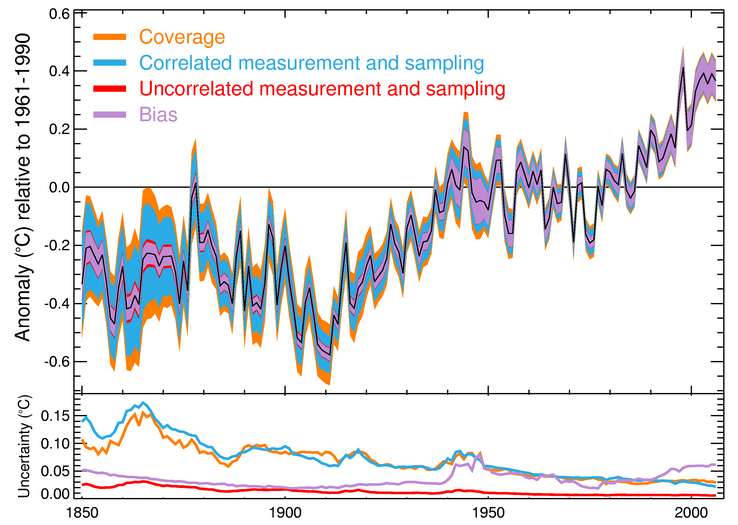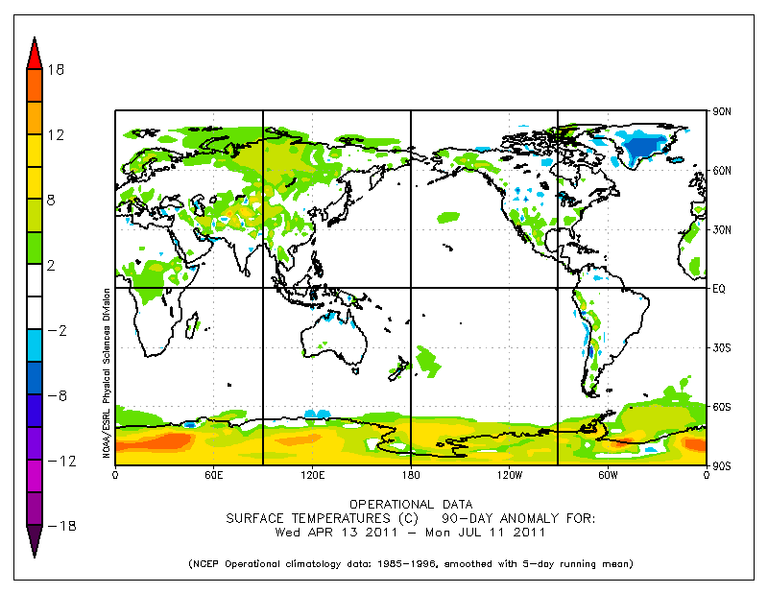Global Highlights indicate continued anomalous warming over Russia; Revisiting historical ocean surface temperatures; Russian Temperature Anomaly; Is Sea-Level Rise Accelerating?; North Pole Cam 1 & 2; Arctic Sea Ice Extent Averaging Below 2007 Anomaly; Paleoclimate Implications for Human-Made Climate Change; UN Security Council Addresses Considers Global Security and Climate Change; New study details glacier ice loss following ice shelf collapse; Climate Change To Spawn More Wildfires; Gingrich Says 2006 Climate Change Ad He Starred In Was ‘Misconstrued’.
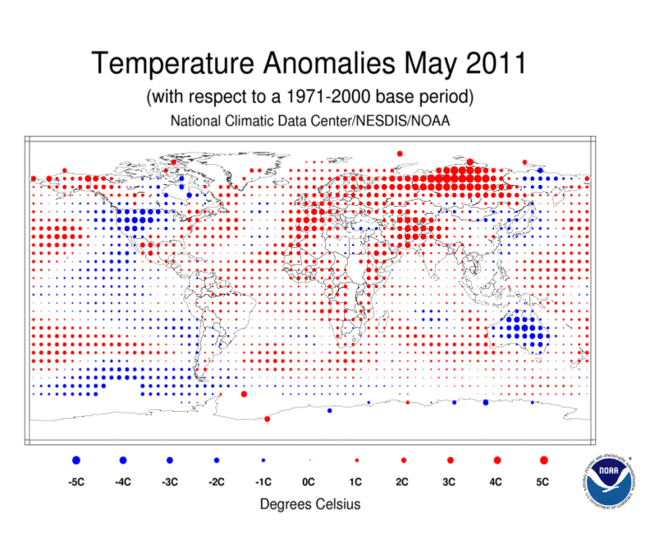
Global Highlights
- The combined global land and ocean average surface temperature for May 2011 was 0.50°C (0.90°F) above the 20th century average of 14.8°C (58.6°F). This is the 10th warmest such value since records began in 1880.
- For March–May 2011, the combined global land and ocean surface temperature was 0.53°C (0.95°F) above average—also the 10th warmest March–May on record.
- The combined global land and ocean average surface temperature for January–May 2011 was the 12th warmest on record. The year-to-date period was 0.48°C (0.86°F) warmer than the 20th century average.
- The global land average surface temperature for May 2011 was the seventh warmest May on record, while March–May ranked as the 10th warmest such period.
- In the Northern Hemisphere, both the May 2011 and March–May average temperatures for land areas were seventh warmest such periods on record.
- The May, March–May, and year-to-date (January–May) worldwide ocean surface temperatures all ranked as the 11th warmest such periods on record.
- La Niña ended during May 2011. Sea surface temperature anomalies in the eastern equatorial Pacific Ocean warmed above the La Niña threshold, signifying a return to ENSO-neutral conditions.
Source: https://www.ncdc.noaa.gov/sotc/global/2011/5
Revisiting historical ocean surface temperatures
Filed under: Climate Science, Instrumental Record, Oceans — gavin @ 11 July 2011
Readers may recall discussions of a paper by Thompson et al (2008) back in May 2008. This paper demonstrated that there was very likely an artifact in the sea surface temperature (SST) collation by the Hadley Centre (HadSST2) around the end of the second world war and for a few years subsequently, related to the different ways ocean temperatures were taken by different fleets. At the time, we reported that this would certainly be taken into account in revisions of data set as more data was processed and better classifications of the various observational biases occurred. Well, that process has finally resulted in the publication of a new compilation, HadSST3.
Source: RealClimate
Russian Temperature Anomaly
by John P. Reisman- July 12, 2011
The chart below illustrates the previous 3 months of temperature anomaly over Russia.
Source: OSS Current Climate Conditions: Temperature
Is Sea-Level Rise Accelerating?
RealClimate Filed under: Climate Science, Oceans — stefan @ 12 July 2011
In a comparrison of the work of Houston and Dean (2011) in Journal of Coastal Research to Vermeer & Rahmstorf (2009) one finds some interesting issues. The Houston and Dean paper admits to cherry picking it’s data points to show ‘no acceleration’ in sea level rise.
They write in the paper: ‘Since the worldwide data of Church and White (2006)…appear to have a linear rise since around 1930, we analyzed the period 1930 to 2010.’
The interval was thus hand-picked to show a linear rise rather than acceleration.
If one subtracts out the non-climatic sea level change due to water stored in artificial reservoirs on land, as we did in Vermeer & Rahmstorf (2009), then the agreement between the acceleration curve predicted from global temperature with the actually observed curve is even better (graph below). Thus, the 1930s acceleration minimum pointed out by Houston & Dean supports our approach and projections rather than challenging them.
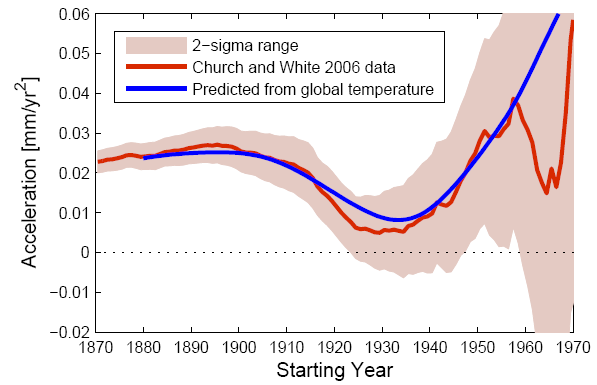
A rebuttal by Stefan Rahmstorf and Martin Vermeer has now been published in JCR.
Source: RealClimate
North Pole Cam 1 & 2
by John P. Reisman – July 17, 2011
Images from the North Pole cameras:
Cam 1 – July 17, 2011

Cam 2 – July 17, 2011
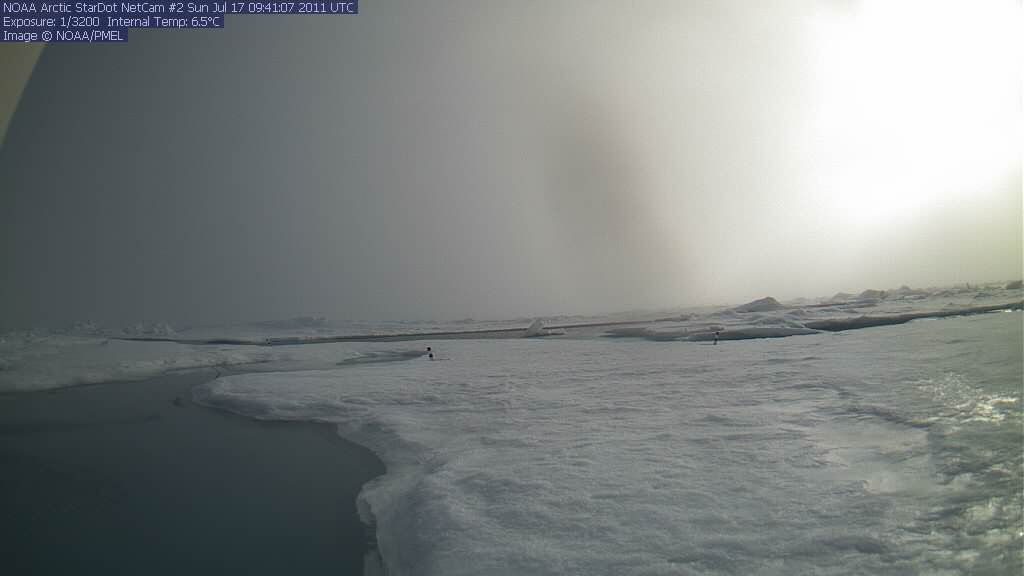
Source: OSS Current Climate Conditions: Arctic
Arctic Sea Ice Extent Averaging Below 2007 Anomaly
by John P. Reisman – July 17, 2011
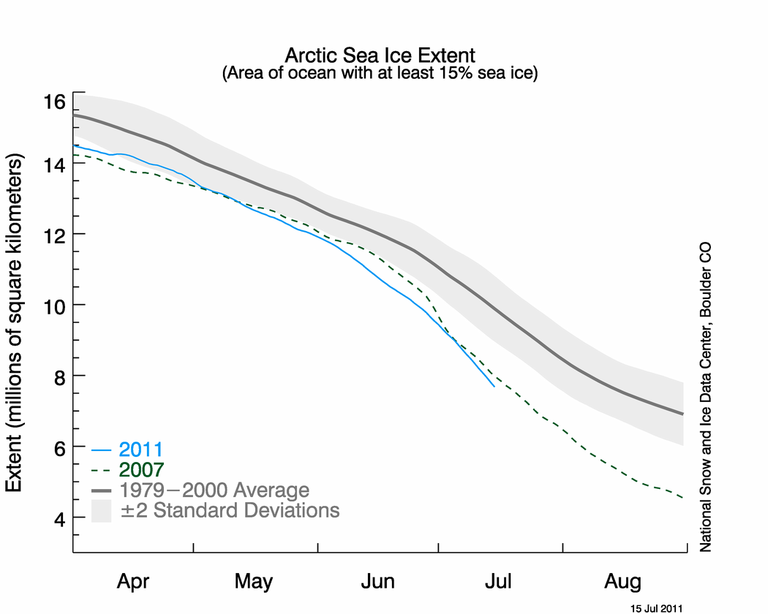
Source: OSS Current Climate Conditions – Arctic
Paleoclimate Implications for Human-Made Climate Change
Abstract: Paleoclimate data help us assess climate sensitivity and potential human-made climate effects. We conclude that Earth in the warmest interglacial periods of the past million years was less than 1{\deg}C warmer than in the Holocene. Polar warmth in these interglacials and in the Pliocene does not imply that a substantial cushion remains between today’s climate and dangerous warming, but rather that Earth is poised to experience strong amplifying polar feedbacks in response to moderate global warming. Thus goals to limit human-made warming to 2{\deg}C are not sufficient – they are prescriptions for disaster. Ice sheet disintegration is nonlinear, spurred by amplifying feedbacks. We suggest that ice sheet mass loss, if warming continues unabated, will be characterized better by a doubling time for mass loss rate than by a linear trend. Satellite gravity data, though too brief to be conclusive, are consistent with a doubling time of 10 years or less, implying the possibility of multi-meter sea level rise this century. Observed accelerating ice sheet mass loss supports our conclusion that Earth’s temperature now exceeds the mean Holocene value. Rapid reduction of fossil fuel emissions is required for humanity to succeed in preserving a planet resembling the one on which civilization developed.
What is notable in this analysis is that it demonstrates a clear difference between where Earth is in temperature now, and where we are going in relation to estimated paleo temperatures in the past 800 thousand years, and the last 5.5 million years. When one considers the total relative radiative forcing levels required to produce these past temperature peaks, and compares that to current industrial imposed forcing, we can see that we are heading into an entirely new climate regime that is not only far outside of the natural range, but based on our current infrastructure, will have far reaching implications for the global economy, based on changes that will impact our existing structure.
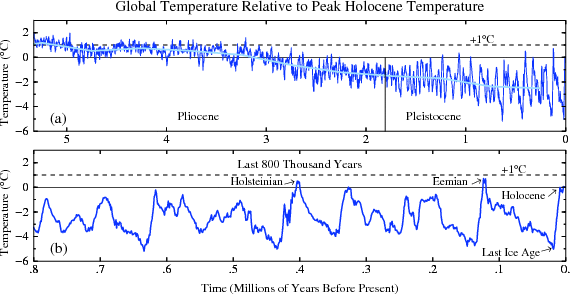
Source: https://arxiv.org/abs/1105.0968v3
Click Here for Popular Science Summary PDF
UN Security Council Addresses Considers Global Security and Climate Change
July 22, 2011 – Al Jazeera Reports
OSS Editorial Note: The UN Security Council debate on climate change was called for by Germany. Raising the issue at this level is very helpful in some ways as it opens the discussion. It remains important that the discussion be practical and achieve relevant conclusions in their assessment. —
The notion of creating a green peace keeping force has been raised. The general consensus from commentators and those experienced in the field, and the position of our own analysis in the complexity of the interrelated issues precludes such a concept. — Never the less, raising the issue does help place a spotlight on the importance of the global security issue related to global warming. — Russia and some others expressed their disappointment in this being an issue. — This means that there is much more to be done regarding education regarding the implications and expectations of climate change in relation to global security and in context of national security.
The UN Security Council has expressed concern that climate change may aggravate threats to international peace and security after what diplomats described as intense negotiations between Germany and Russia, which initially opposed any council action.
Small island states, which could disappear beneath rising seas, are pushing the Security Council to intervene to combat the threat to their existence. Meanwhile there has been talk of a new environmental peacekeeping force – the green helmets – which could step into conflicts caused by shrinking resources.
The final statement expressed “concern that possible adverse effects of climate change may, in the long run, aggravate certain existing threats to international peace and security”.
The Security Council had failed to agree on whether climate change was an issue of world peace in 2007, when Britain brought up the matter. This is one of the first debates that will be occurring within that forum, which raises the whole issue of the security implications around climate change and the potential security implications for the world.
Is it a real opportunity to achieve significant results or an attempt to divert attention away from the root causes of the problem and from the countries that cause global warming and to distribute the burden evenly on all nations?
Note: There is a 25 minute video discussing related issues regarding the meeting. Please follow the source link. Inside Story, with presenter Jane Dutton, discusses with guests: Sabrina Chesterman, a climate change consultant based in South Africa; Tobias Seakin, a senior research fellow and the director of National Security and Resilience; and Cleo Paskal, an associate fellow with the Energy, Environment and Development Programme.
Source: Al Jazeera
New study details glacier ice loss following ice shelf collapse
An international team of researchers has combined data from multiple sources to provide the clearest account yet of how much glacial ice surges into the sea following the collapse of Antarctic ice shelves.
The work by researchers at the University of Maryland, Baltimore County (UMBC), the Laboratoire d’Etudes en Géophysique et Océanographie Spatiales, Centre National de la Recherche Scientifique at the University of Toulouse, France, and the University of Colorado’s National Snow and Ice Data Center (NSIDC) details recent ice losses while promising to sharpen future predictions of further ice loss and sea level rise likely to result from ongoing changes along the Antarctic Peninsula.
“Not only do you get an initial loss of glacial ice when adjacent ice shelves collapse, but you get continued ice losses for many years—even decades—to come,” says Christopher Shuman, a researcher at UMBC’s Joint Center for Earth Systems Technology (JCET) at the NASA Goddard Space Flight Center. “This further demonstrates how important ice shelves are to Antarctic glaciers.”
Shuman is lead author of the study “2001-2009 elevation and mass losses in the Larsen A and B embayments, Antarctic Peninsula“ published online today in the Journal of Glaciology.
 |
| Crane Glacier is one of the several Antarctic glaciers that fed into the Larsen B Ice Shelf, which dramatically collapsed in 2002. A new study provides detailed information on how much ice these glaciers are losing into the ocean. |
| —Credit: Erin Pettit, University of Alaska Fairbanks |
Source: NSIDC
Climate Change To Spawn More Wildfires
Large fires are predicted for the Rockies and Yellowstone with the potential to push the area over a tipping point.
By Emily Sohn
Mon Jul 25, 2011 03:00 PM ET
- Severe wildfires are becoming common in the northern Rockies, as a result of climate change.
- By the end of the century, large fires are likely to strike 10 times more often.
- At risk are many types of plants, animals and people who live in the mountainous west.
As Earth’s climate warms up, Yellowstone National Park and the Grand Tetons are likely to experience large fires more frequently, according to a new study. Within just a few decades, big fires may become as much as 10 times more common than they have been in the last 10,000 years.
A bump in fire frequency would reverberate through the environment in unpredictable ways — affecting the kinds of plants that grow in the area, the kinds of animals that can find habitats there and the amount of carbon that vegetation might be expected to pull out of the atmosphere.
Yellowstone and the Rockies will likely see more large fires due to climate change. Click to enlarge this image.
Corbis
Source: Discovery News
Gingrich Says 2006 Climate Change Ad He Starred In Was ‘Misconstrued’
By Jason Linkins First Posted: 7/26/11 04:55 PM ET Updated: 7/26/11 04:55 PM ET
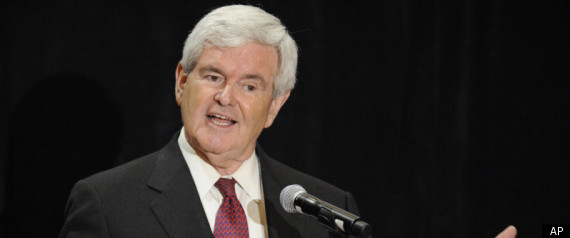
Back in 2006, Newt Gingrich was a ‘Man Of Ideas’. And one of the ideas he had was that he would appear in a PSA with Nancy Pelosi, paid for by the Alliance for Climate Protection, which was founded by Al Gore. In that PSA, Gingrich said things like:
“We do agree, our country must take action to address climate change,”
and
“if enough of us demand action from our leaders, we can spark the innovation we need.”
Back to the Present – Gingrich recently said on WGIR radio of the 30-second television commercial, says:
“I was trying to make a point that we shouldn’t be afraid to debate the left, even on the environment,” “Obviously it was misconstrued, and it’s probably one of those things I wouldn’t do again.”
Watch his original statements on YouTube (Click Here)
The fact that politicians think it is completely acceptable to change their positions based on various populist contexts designed only to augment their current standing implies and/or confirms a near total lack of integrity on their parts.
Source: Huffington Post

